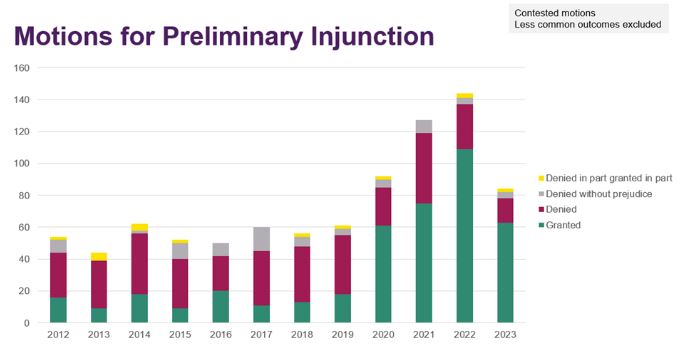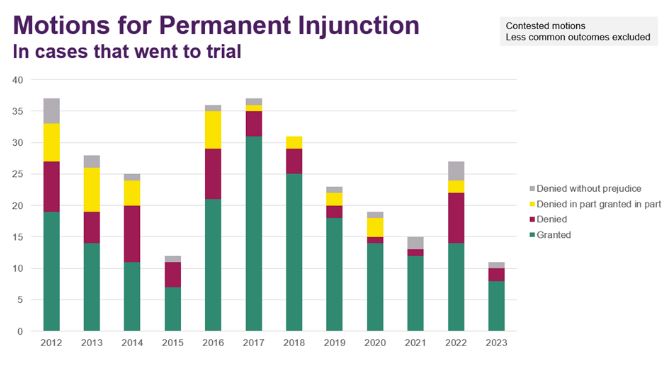By: Nirav Desai, Patrick Murray, and Roberta Lam
Law360 (August 2, 2023, 5:28 PM EDT) –With the launch of the European Union’s Unified Patent Court this past June, there is much speculation and suggestion that injunctive relief will be more accessible there than in U.S. courts.
From a global strategy perspective, the prospects of injunctive relief across all signatory states in the Agreement on a Unified Patent Court, or UPCA, should place the UPC on every innovative company’s radar as a potential venue for patent enforcement and defense.
However much remains to be seen regarding how the UPC will treat injunctive relief in practice, particularly because that court draws from several bodies of substantive law. In contrast, the U.S. legal framework guiding both preliminary and permanent injunctions has evolved over the years and is backed by decades of established precedent and case law.
A commonly held belief is that injunctive relief is nearly impossible to obtain in the U.S, but the trends in recent years show that the tides may be turning in favor of injunction.
U.S. Legal Framework for Injunctive Relief
In the U.S., injunctive relief is available preliminarily — typically at the time of filing a complaint for patent infringement, and permanently — at the end of the case after the patent owner has prevailed.
Injunctive relief is considered an extraordinary remedy because of the potential consequences to the enjoined party’s business. Accordingly, significant jurisprudence has developed in the form of the Winter factors for preliminary injunction and the eBay factors for permanent injunction.
The Winter Factors and Preliminary Injunctive Relief
U.S. courts determine whether a preliminary injunction is appropriate using the test from the U.S. Supreme Court 2008 decision in Winter v. Natural Resources Defense Council Inc. This test involves four factors:
- Whether the plaintiff is likely to succeed on the merits;
- Whether the plaintiff is likely to suffer irreparable harm without the injunction;
- Whether the balance of equities and hardships is in the plaintiff’s favor; and
- Whether an injunction is in the public interest.[1]
From 2022-2023, U.S. courts have granted 11 out of 93 utility patent cases a preliminary injunction, roughly 12%.
Failure to demonstrate a likelihood of success on the merits may account for one of the most common justification for a denial because utility patent cases are inherently complex and require more intricate analysis involving Markman hearings, claim construction and infringement analysis.
Additionally, there are high evidentiary hurdles for a patentee to demonstrate that the harms they propose are more than mere speculation.
The eBay Factors and Permanent Injunctive Relief
U.S. courts determine whether a permanent injunction is appropriate using the test from the 2006 Supreme Court decision in eBay Inc. v. MercExchange LLC.
Under this test, the proponent must prove that:
- It has suffered an irreparable injury;
- Legal remedies are insufficient compensation;
- A remedy in equity is necessary; and
- A permanent injunction would not be counter to public policy.[2]
Under eBay, the Supreme Court has held that the Patent Act does not create a predisposition for the granting of permanent injunctions.
Rather, the court has firmly held that the equity principles of injunctive relief apply in patent cases as it does in any other cases. From 2022-2023, U.S. courts have granted 22 out of 38 utility patent cases a permanent injunction, which is roughly 58%.
U.S. Trends and Exceptions
An analysis of data from Docket Navigator reveals a recent uptick in both the number of motions for preliminary injunctions as well as the frequency that these motions are granted in patent cases.
It’s important to note that these trends appear to be driven in large part by anti-counterfeiting cases involving design patents filed against so-called John Doe defendants, particularly in the U.S. District Court for the Northern District of Illinois.
At the same time, the analysis underscores the extent to which persuasive arguments can secure preliminary injunctions despite the legal headwinds against plaintiffs receiving this type of relief.
Similar Docket Navigator data shows that in patent cases that have gone to trial, courts grant motions for permanent injunctions in a majority of cases.
Despite this trend in outcomes, plaintiffs have tended to seek injunctive relief after trial in fewer cases over the past several years, perhaps suggesting that only the strongest arguments for permanent injunctions are being presented to judges.
The circumstances of the case are important as well. U.S. courts will carve out exceptions for injunctive relief if there is sufficient evidence to call into question the ability of both parties’ ability to return to the status quo.
For example, appellate courts have repeatedly recognized that injunctions may be “appropriate based on barriers to collectability after judgment,” as per the 2017 SAS Institute Inc. v. World Programming Ltd. decision in the U.S. Court of Appeals for the Fourth Circuit.[3]
Courts will examine the defendant’s assets and take into account obligations owed by insolvents when determining whether monetary damages is an available remedy.[4]
Finally, the U.S. is a particularly favorable venue for design patents. From 2022-2023, 62 out of 69 design patents were granted a preliminary injunction, roughly 90%. This is an increase from 2021-2022, where 43 out of 56 design patents were granted a preliminary injunction, roughly 77%.
For the design patents that were taken to trial in 2022 and 2023, 81 out of 83 design patents were granted a permanent injunction, which is roughly 98%. This is also an increase from 2021-2022, where 48 out of 56 design patents were granted a permanent injunction, roughly 92%.
Concluding Remarks
While the predicted availability of injunctive relief is one reason the UPC is the hottest topic in intellectual property circles at the moment, recent trends suggest that the U.S. is still a great destination for injunctive relief in many situations.
The U.S. represents a significant share in terms of gross domestic product — even when compared to the combined UPCA signatory states ($26.9 trillion vs. $15.5 trillion)[5] — which makes it a venue of economic importance that cannot be ignored.
As a new court, the UPC may face certain hurdles of reconciling multiple bodies of law when it is establishing precedent and its own body of case law.
Like U.S. courts, the UPC will consider “the need for proportionality between the seriousness of the infringement and the remedies to be ordered, the willingness of the infringer to convert the materials into a non-infringing state, as well as the interests of third parties,” according to the June 6, 2013 Agreement on a Unified Patent Court.[6]
Additionally, the UPC has the discretion to balance the interests of the parties and the potential harm for either of the parties resulting from the granting or the refusal of the injunction.[7] It remains to be seen how the UPC will consider proportionality and the interests and hardships of both patentee and infringer when determining whether injunctive relief is an available remedy.
What is clear, however, is that the introduction of the UPC has caused a significant shift in the global IP landscape, and IP strategy playbooks around the world should be pulled off shelves and updated.
Nirav Desai is a director in the trial and appellate practice group, and the electronics practice group, at Sterne Kessler Goldstein & Fox PLLC.
Patrick Murray is the manager of business development and analytics at the firm.
Roberta Lam is a student at the University of Arizona’s James E. Rogers College of Law. She was a 2023 summer associate at Sterne Kessler.
The opinions expressed are those of the author(s) and do not necessarily reflect the views of their employer, its clients, or Portfolio Media Inc., or any of its or their respective affiliates. This article is for general information purposes and is not intended to be and should not be taken as legal advice.
[1] Winter v. Natural Resources Defense Council Inc., 555 U.S. 7, 20 (2008).
[2] eBay Inc. v. MercExchange LLC, 547 U.S. 388, 391 (2006).
[3] SAS Inst. Inc. v. World Programming Ltd., 874 F.3d 370, 387 (4th Cir. 2017).
[4] SAS Inst. Inc. v. World Programming Ltd., 874 F.3d 370, 386-87 (4th Cir. 2017); Brenntag Int’l Chemicals Inc. v. Bank of India, 175 F.3d 245, 250 (2d Cir. 1999).
[5] See https://www.imf.org/en/Publications/WEO/weo-database/2023/April and https://www.unified-patent-court.org/en/organisation/upc-member-states
[6] Agreement on a Unified Patent Court, June 6, 2013.
[7] Agreement on a Unified Patent Court, June 6, 2013.
Related Services

Receive insights from the most respected practitioners of IP law, straight to your inbox.
Subscribe for Updates

